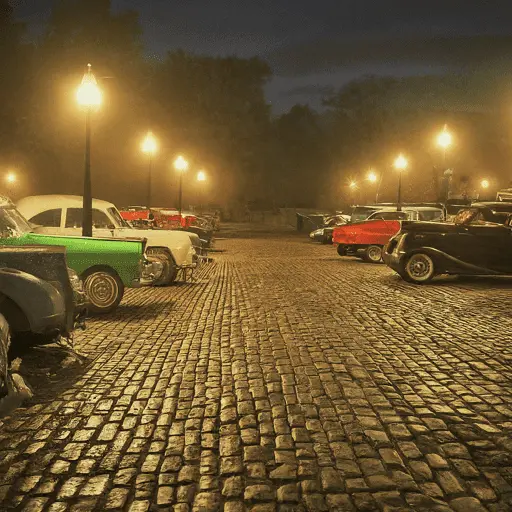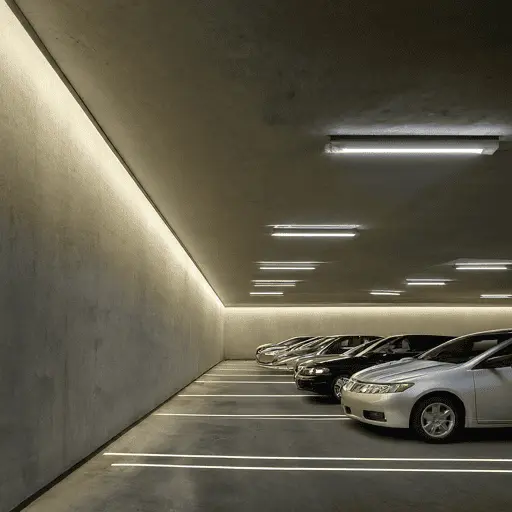Правильное освещение на парковках имеет решающее значение для обеспечения безопасности, защищенности и общего приятного впечатления для посетителей. Независимо от того, управляете ли вы коммерческим помещением, общественным учреждением или частной собственностью, обеспечение хорошего освещения вашей парковки может значительно снизить количество несчастных случаев и сдержать преступную деятельность.
В этом руководстве мы рассмотрим все, что вам нужно знать о выборе лучших светильников для парковки: от понимания различных доступных типов до знания того, какие факторы следует учитывать перед совершением покупки. Это подробное руководство для покупателя призвано помочь владельцам и менеджерам недвижимости принимать обоснованные решения для повышения безопасности и привлекательности своих помещений.
Важность освещения парковки
А. Проблемы безопасности
Освещение парковочных мест играет жизненно важную роль в предотвращении несчастных случаев, особенно столкновений пешеходов и транспортных средств. Достаточное освещение гарантирует, что водители и пешеходы смогут четко видеть друг друга, что снижает риск несчастных случаев. Кроме того, хорошо освещенные парковки улучшают видимость в условиях низкой освещенности, например, ночью или в плохую погоду, позволяя водителям безопасно передвигаться.
Б. Проблемы безопасности
Хорошо освещенная парковка служит сдерживающим фактором для краж, вандализма и других преступных действий. Яркое и равномерное освещение исключает темные углы, где могут спрятаться преступники, создавая более безопасную среду как для посетителей, так и для сотрудников. Улучшенная видимость повышает чувство безопасности, позволяя людям чувствовать себя более комфортно при въезде на парковку, особенно в вечерние часы.
C. Эстетическое воздействие
Помимо безопасности и защищенности, парковочные фонари также оказывают значительное эстетическое воздействие на имущество. Правильно спроектированное освещение может улучшить внешний вид коммерческих и общественных объектов, сделав их более привлекательными и профессиональными. То, как освещена парковка, часто формирует первое впечатление о бизнесе или месте, отражая качество и внимание к деталям заведения.
Типы светильников для парковок
Существует несколько типов парковочных светильников, предназначенных для повышения безопасности, видимости и эстетики. Вот основные типы парковочных светильников:
| Тип освещения парковки | Описание | Преимущества |
|---|---|---|
| Светодиодные фонари для парковки | Энергоэффективный, долговечный и широко используемый. | Низкое энергопотребление, минимальное обслуживание, отличная яркость. |
| Полюсные фонари | Эти фонари, установленные на высоких столбах, обеспечивают широкое освещение больших площадей. | Идеально подходят для парковок, обеспечивают равномерное распределение света, улучшая видимость как для транспортных средств, так и для пешеходов. |
| Зональные огни | Предназначен для освещения больших открытых пространств, может быть установлен на столбах или зданиях. | Повышает безопасность за счет освещения окружающей местности, снижая опасность для пешеходов и транспортных средств. |
| Прожекторы | Обеспечить интенсивный, направленное освещение для покрытия обширных территорий. | Идеально подходит для больших открытых пространств, улучшая видимость и безопасность на парковках. |
| Болларды огни | Короткие, прочные светильники, украшающие дорожки или периметры. | Повышает безопасность пешеходов, обеспечивая направленное освещение вдоль пешеходных дорожек и подъездных путей, что идеально подходит для парковок. |
| Навесные светильники | Устанавливается непосредственно над головой в таких сооружениях, как заправочные станции или гаражи. | Обеспечивает достаточное освещение на открытых площадках, повышая безопасность клиентов и транспортных средств. |
| Индукционные лампы | Высокая эффективность с длительным сроком службы. | Низкие затраты на техническое обслуживание и эксплуатацию, идеально подходят для больших помещений. |
| Солнечные фонари | Используйте солнечную энергию для освещения парковочных мест. | Экологически чистый и простой в установке, снижает затраты на электроэнергию и идеально подходит для удаленных мест. |
| Освещение высокой мачты | Высокие столбы с множеством светильников наверху для освещения больших площадей, таких как шоссе или большие парковки. | Обеспечивает обширное покрытие и уменьшает количество необходимых опор, сводя к минимуму визуальный беспорядок. |
| Светильники для обувных коробок | Прямоугольные светильники, напоминающие по форме коробку из-под обуви, закрепленные на столбах. | Отличная однородность и высокая эффективность, что делает их популярным выбором для парковок. |
Выбор правильного типа освещения парковки имеет решающее значение для повышения безопасности, защищенности и видимости на открытых пространствах. Принимая во внимание такие факторы, как энергоэффективность, требования к установке и особые потребности в освещении, вы можете выбрать наиболее подходящие решения освещения для вашей парковки.

Ключевые факторы, которые следует учитывать при покупке светильников для парковки
При покупке светильников для парковки следует учитывать несколько ключевых факторов, обеспечивающих безопасность, эффективность и результативность. Вот важные аспекты, которые следует учитывать:
А. Яркость (люмены)
Яркость света измеряется в люмены, что напрямую влияет на обзорность и безопасность на парковках. Для небольших парковок обычно достаточно от 10 000 до 20 000 люмен, тогда как для более крупных коммерческих парковок может потребоваться от 40 000 до 60 000 люмен или более.
Цель состоит в том, чтобы обеспечить достаточно света для улучшения видимости как для водителей, так и для пешеходов, не создавая бликов или чрезмерной яркости.
B. Углы луча и распределение света
Углы луча определить, насколько широко или узко распространяется свет. Широкие углы луча (от 90 до 120 градусов) охватывают большие площади, а узкие углы луча (менее 30 градусов) фокусируют свет на определенных участках.
Некоторые светодиодные светильники оснащены регулируемыми или зум-линзами, что позволяет изменять угол луча в соответствии с конкретными потребностями в освещении, обеспечивая большую гибкость.
Равномерное распределение света необходимо для предотвращения темных пятен и повышения безопасности. Различные модели распределения, такие как Тип II (узкий), Тип III (широкий), Тип IV (направленный вперед) и Тип V (круговой), подходят для различных планировок и потребностей парковочных мест.
C. Цветовая температура и CRI
Цветовая температура, измеряемая в Кельвинах (К), влияет на внешний вид света. Более теплые тона (3000K) мягче и создают уютную атмосферу, а более холодные тона (5000K) повышают видимость и безопасность.
Индекс цветопередачи (CRI) важен для различения цветов при искусственном освещении, особенно в зонах, требующих контроля безопасности.
E. Долговечность и устойчивость к атмосферным воздействиям
Для наружного освещения ключевым моментом является долговечность. Такие материалы, как алюминий или поликарбонат, обеспечивают прочность и устойчивость к атмосферным воздействиям. Обратите внимание на классы IP, например IP65 или IP66, чтобы убедиться, что фонари водонепроницаемы, пыленепроницаемы и способны выдерживать суровые погодные условия.
F. Варианты монтажа
В зависимости от дизайна вашего участка вы можете выбрать светильники, закрепленные на столбе или на стене. Светильники, установленные на столбе, часто размещаемые на высоте от 15 до 40 футов, обеспечивают широкое освещение, тогда как настенные светильники могут лучше подходить для небольших, сосредоточенных участков. Высота и угол установки существенно влияют на распространение света и эффективность.
G. Датчики движения и интеллектуальное управление
Добавление датчиков движения к освещению вашей парковки может сэкономить энергию, освещая области только при обнаружении движения. Интеллектуальное управление предлагает такие функции, как затемнение, планирование и дистанционное управление, которые могут оптимизировать как энергопотребление, так и безопасность.
H. Соблюдение требований и правила
Убедитесь, что ваша установка освещения соответствует местным нормам относительно светового загрязнения и ограничений яркости. Стандарты таких организаций, как OSHA и Общество светотехники (IES), также содержат рекомендации по безопасности и эффективности коммерческого освещения.
I. Модернизация или новые установки
Если вы переходите со старых HID-ламп на современные светодиоды, модернизация может оказаться экономически эффективным решением. Например, металлогалогенную лампу мощностью 1500 Вт можно заменить светодиодом мощностью 500 Вт для получения эквивалентной люменов. Аналогичным образом, лампы HID мощностью 1000 Вт можно заменить светодиодами мощностью 300 Вт, что обеспечивает значительную экономию энергии и лучшую светоотдачу.
Тщательно учитывая эти факторы при выборе освещения для парковки, вы можете создать хорошо освещенную среду, которая повысит безопасность и защищенность, будучи при этом энергоэффективной и экономичной.
Советы по установке светильников для парковок
A. Правильное расстояние и расположение
Чтобы добиться равномерного распределения света, крайне важно правильно расположить светильники, обеспечив равномерное освещение без темных пятен или чрезмерного перекрытия. Тщательно спланируйте размещение светильников, чтобы обеспечить сбалансированное освещение всей парковки, избегая участков, которые либо недостаточно освещены, либо слишком ярко освещены из-за перекрытия лучей.
Если вы используете установку на столбе, ниже приведены рекомендуемые места для справки:
- Жилые и небольшие коммерческие участки: Для опор высотой от 15 до 20 футов используйте светильники мощностью от 10 000 до 20 000 люмен, расположенные на расстоянии 20–30 футов друг от друга. Установка двух светильников на опору улучшит распределение света.
- Средние коммерческие участки: Для опор высотой от 20 до 25 футов выбирайте светильники, генерирующие от 20 000 до 30 000 люмен, расположенные на расстоянии 30–40 футов друг от друга. Регулировка углов луча может помочь точно настроить распространение и направление света.
- Крупномасштабные или промышленные участки: Для высоких мачтовых опор высотой от 25 до 35 футов установите светильники, излучающие от 30 000 до 70 000 люмен, на расстоянии 40–50 футов друг от друга. Используйте различные варианты монтажа и аксессуары для обеспечения оптимального освещения и эффективности.
B. Высота и угол установки
Выбирайте высоту столба в зависимости от размера участка, чтобы обеспечить наилучшее освещение. Высокие опоры распространяют свет на большую площадь, но требуют более прочных светильников. Правильная регулировка угла помогает предотвратить попадание света в нежелательные области и уменьшает блики, улучшая видимость и экономя энергию.
C. Рекомендации по подключению и питанию
Разные типы освещения требуют разной электрической нагрузки. Убедитесь, что ваша система проводки достаточно надежна, чтобы обеспечить мощность выбранных вами светильников без перегрузки цепей. Правильная установка с правильным сечением проводки помогает предотвратить потери энергии и обеспечивает долговечность системы освещения.
D. Техническое обслуживание и очистка
Регулярное техническое обслуживание имеет жизненно важное значение для обеспечения долгосрочной работы. Периодически очищайте линзы, чтобы предотвратить накопление грязи, которая может снизить светоотдачу. Осмотрите крепления и опоры на наличие признаков износа, коррозии или повреждений, чтобы убедиться, что система остается работоспособной и безопасной в течение длительного времени.

Долгосрочные сбережения и скидки
А. Первоначальные инвестиции и долгосрочные сбережения
При рассмотрении стоимости освещения парковки важно сопоставить первоначальные инвестиции с долгосрочной экономией. Светодиодные фонари поначалу могут стоить дороже, чем традиционные варианты, такие как HID или люминесцентные лампы. Однако светодиоды со временем экономят деньги, поскольку они потребляют меньше энергии и требуют меньшего обслуживания.
Например, газоразрядные лампы потребляют больше энергии и часто требуют более частой замены ламп, что увеличивает текущие расходы. Освещение на солнечной энергии также может быть дороже на начальном этапе, особенно с солнечными панелями, но оно полностью устраняет затраты на электроэнергию.
- Первоначальные затраты: хотя установка светодиодных светильников может оказаться дороже, они помогают снизить ежемесячные счета за электроэнергию.
- Долгосрочная экономия: преимущества светодиодных фонарей проявляются со временем, особенно на больших парковках. Экономия достигается не только за счет меньшего энергопотребления, но и за счет меньшего обслуживания, поскольку светодиоды служат дольше и долговечнее.
Выбирая энергоэффективные варианты, предприятия могут значительно сэкономить в течение срока службы системы освещения, что оправдывает первоначальные инвестиции.
Б. Скидки и стимулы
Еще одним важным фактором является наличие скидок и стимулов, которые могут помочь снизить стоимость энергоэффективного освещения. Многие местные и федеральные программы, а также коммунальные компании предлагают финансовую помощь для поощрения использования устойчивых технологий, таких как светодиоды и солнечные фонари. Эти стимулы могут значительно снизить первоначальные затраты, упрощая переход на более эффективное освещение.
- Скидки государственным и коммунальным предприятиям: ищите скидки от местных энергетических компаний или государственных программ, которые поддерживают модернизацию энергоэффективного освещения. Это может помочь снизить затраты на установку для предприятий.
- Примеры: Многие штаты предоставляют программы скидок специально для предприятий, устанавливающих светодиодные фонари для парковок, возвращая процент от стоимости после установки. Солнечные проекты также могут претендовать на федеральные налоговые льготы или местные гранты для продвижения возобновляемой энергетики.
Использование этих программ может сделать переход на светодиодное или солнечное освещение парковок более доступным.
C. Срок службы и стоимость замены
Срок службы системы освещения является еще одним ключевым фактором. Различные типы ламп служат разное время и требуют замены с разной скоростью, что влияет на долгосрочные затраты. Например, светодиодные лампы обычно служат от 50 000 до 100 000 часов, что намного дольше, чем HID или люминесцентные лампы. Это означает, что светодиоды необходимо заменять реже, что экономит деньги как на материалах, так и на рабочей силе.
- Сравнение продолжительности жизни: светодиодные лампы могут служить в 5-10 раз дольше, чем традиционные HID или люминесцентные лампы. HID-лампы обычно служат от 15 000 до 25 000 часов, а люминесцентные лампы — от 10 000 до 30 000 часов.
- Затраты на замену: HID-светильники требуют частой замены ламп и балластов, что увеличивает затраты на техническое обслуживание. Напротив, светодиодные фонари предназначены для минимального обслуживания, сокращая время простоя и затраты на рабочую силу. Солнечные фонари могут нуждаться в периодическом обслуживании солнечных панелей, но обычно это происходит нечасто.
Выбирая лампы с более длительным сроком службы, такие как светодиоды, предприятия могут избежать частой замены и сэкономить на техническом обслуживании и расходах на материалы, увеличивая общую экономию.
Часто задаваемые вопросы (FAQ)
1. Какова идеальная высота фонарных столбов для парковки?
Идеальная высота фонарных столбов для парковки зависит от размера участка и необходимого уровня освещенности.
Для жилых и небольших коммерческих участков высота столбов обычно составляет от 15 до 20 футов. Для коммерческих помещений среднего размера чаще используются столбы высотой от 20 до 25 футов, обеспечивающие более широкое покрытие.
Для крупных или промышленных объектов высота столбов может составлять от 25 до 35 футов и выше, часто используют освещение на высоких мачтах для освещения обширных площадей. Более высокие опоры уменьшают количество необходимых светильников, но требуют освещения с большей яркостью для обеспечения видимости.
2. Сколько люмен мне нужно для стандартной парковки?
Количество люменов, необходимых для парковки, зависит от размера площади и предполагаемого использования. Для небольших парковок обычно достаточно светильников мощностью от 12 000 до 18 000 люмен, тогда как для парковок среднего размера может потребоваться от 20 000 до 30 000 люмен на светильник.
Большим или промышленным объектам для адекватного освещения обычно требуется от 30 000 до 70 000 люмен.
Хорошее правило — иметь от 2 до 4 люменов на квадратный фут, хотя конкретные потребности могут варьироваться в зависимости от схемы освещения, высоты опоры и распределения света.
3. Являются ли солнечные фонари для парковок хорошим вариантом для любого климата?
Солнечные фонари для парковок могут быть отличным энергосберегающим вариантом, но их эффективность зависит от климата. В районах с постоянным солнечным светом солнечные фонари могут эффективно обеспечить достаточное освещение при минимальном обслуживании.
Однако в пасмурный или дождливый климат их надежность может снизиться, поскольку для зарядки в светлое время суток они полагаются на солнечные панели.
В экстремальных зимних условиях снег или лед могут засорять панели, снижая их эффективность. В таком климате для обеспечения постоянного освещения могут потребоваться гибридные системы или резервное питание.
4. Каков срок службы светодиодных и HID-ламп?
Светодиодные лампы обычно имеют гораздо более длительный срок службы по сравнению с HID-лампами. Светодиоды могут прослужить от 50 000 до 100 000 часов, в зависимости от качества и условий использования, что делает их очень долговечными и не требующими особого ухода.
С другой стороны, HID-лампы обычно служат от 15 000 до 25 000 часов, а это означает, что они требуют более частой замены. Более длительный срок службы светодиодов не только снижает затраты на техническое обслуживание, но и делает их более экономичным решением в долгосрочной перспективе.
5. Как уменьшить блики при освещении парковки?
Уменьшение бликов имеет важное значение для поддержания видимости и безопасности на парковках. Чтобы свести к минимуму блики, рассмотрите возможность использования светильников с регулируемым углом луча и выберите конструкции с отсекателями, которые направляют свет вниз, а не наружу.
Установка светильников на правильной высоте и под правильным углом также помогает предотвратить попадание света в нежелательные зоны или создание слепых зон для водителей и пешеходов.
Кроме того, выбор ламп с более низкой цветовой температурой (около 3000–4000 К) может уменьшить резкость, способствуя созданию более мягкой и комфортной среды освещения.
Для достижения наилучших результатов рассмотрите возможность консультации со специалистом по освещению или проведения тщательной оценки освещения, чтобы адаптировать решения к вашим конкретным потребностям. Инвестиции в правильную систему освещения обеспечат более безопасную, экономичную и визуально привлекательную парковку на долгие годы вперед.
Автор
-

Я Джозеф, соучредитель CST Lighting, обладающий более чем десятилетним опытом работы в индустрии светодиодного освещения. Уделяя особое внимание маркетингу продукции, я стремлюсь оставаться в авангарде рыночных тенденций, постоянно совершенствуя свои знания и навыки, чтобы предоставлять нашим клиентам первоклассные продукты и услуги. В наших содержательных сообщениях в блогах мы стремимся поделиться своим опытом, знакомя читателей с постоянно развивающейся сферой светодиодного освещения.
Просмотреть все сообщения
Узнайте больше через мой профиль linkedin https://www.linkedin.com/in/ledcst-joseph/